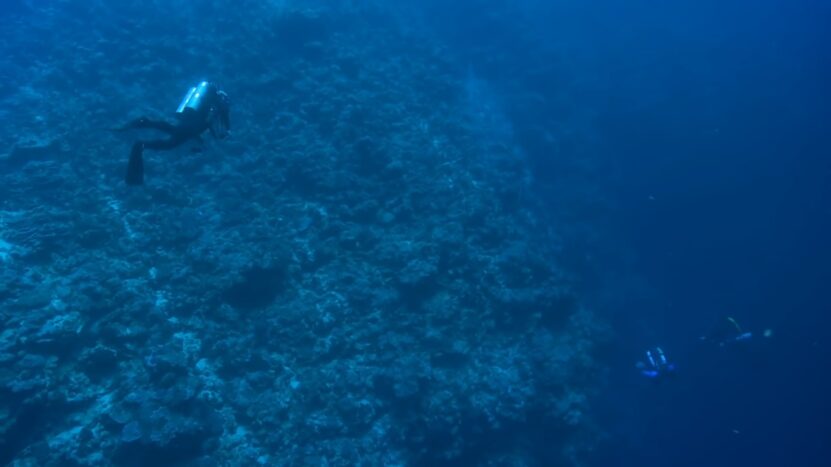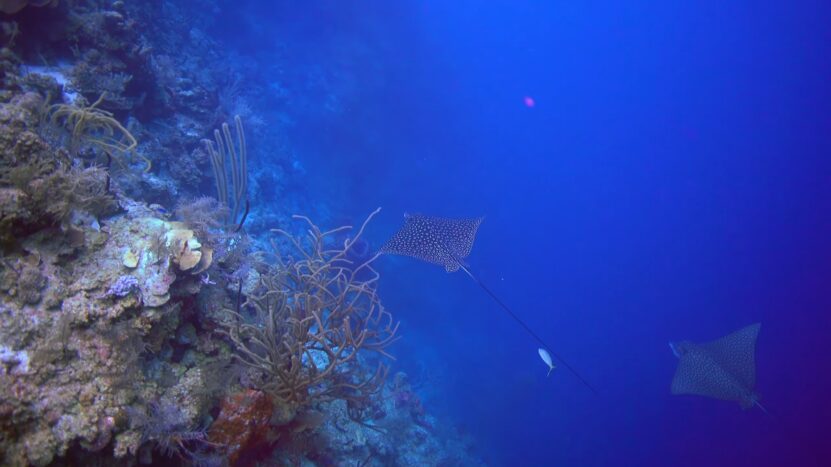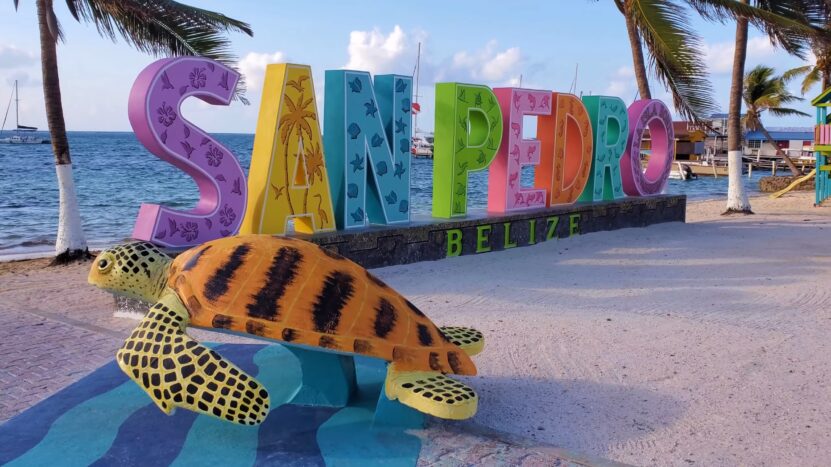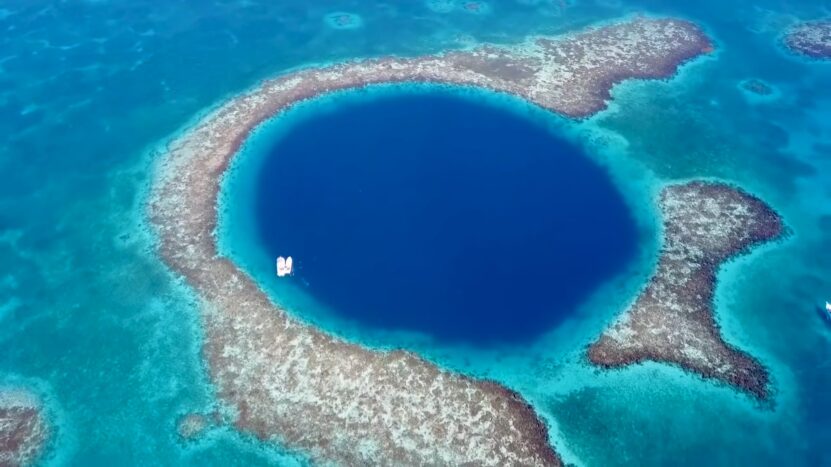The Great Blue Hole is a famous tourist attraction in Belize known for its stunning beauty and exceptional diving opportunities. However, many people who visit this natural wonder do not fully understand it.
Here are 10 fascinating facts about the Great Blue Hole that will help you appreciate it more, whether you have dived in Belize before or are considering a trip.
Formation of the Great Blue Hole Belize
The Great Blue Hole Belize is a natural wonder known for its incredible beauty and diving opportunities. It is a massive marine sinkhole that was formed over thousands of years. The process of its formation began approximately 153,000 years ago during low sea levels and continued as the ocean rose higher and higher, thus creating a deeper hole.
The formation of the Great Blue Hole Belize happened in stages, with the initial stage being a sinkhole that formed when the sea level was much lower than it is today. During this time, the area where the Great Blue Hole is now was a large limestone cave system that was gradually flooded as the sea level began to rise. The dissolution of the limestone by the acidic rainwater caused the cave system to collapse, forming a massive sinkhole.
As the ocean continued to rise, the sinkhole filled with water, forming a deep, circular hole. The walls of the hole were carved out by waves, currents, and other natural forces, creating a breathtaking underwater cave system. The hole’s distinctive deep blue color is due to the crystal-clear water that fills it, which is over 400 feet deep.
Size and Depth of the Great Blue Hole Belize
The Great Blue Hole Belize is a giant marine sinkhole known for its impressive size and depth. It measures almost 1000 feet across or, 984 feet in diameter, and has a depth of approximately 407 feet.
The circular shape of the Great Blue Hole Belize is a result of its formation process. The sinkhole that formed the hole was initially much smaller but gradually widened as it collapsed and filled with water over thousands of years. Its enormous size makes it the largest natural formation of its kind in the world.
The depth of the Great Blue Hole Belize is another remarkable feature. The water in the hole is over 400 feet deep, making it an exciting but challenging diving spot. The crystal-clear water allows divers to see an incredible range of marine life and explore the underwater cave system that makes the Great Blue Hole so famous.
Underwater Caves of the Great Blue Hole Belize

The Great Blue Hole Belize is not only known for its impressive size and depth but also for its complex underwater cave system. The hole features a total of 11 underwater caves that vary in depth and length. The most shallow cave is the Great Blue Hole, measuring 124 meters or 400 feet, while the deepest cave is the Actun Box Ch’iich, which is 183 meters or 600 feet deep.
The underwater caves of the Great Blue Hole Belize are a popular destination for experienced divers looking for a unique and challenging diving experience. The caves are not only beautiful but also ecologically important, as they are home to a wide range of marine life, including various types of fish, sharks, and coral.
The caves of the Great Blue Hole in Belize vary in size and complexity. Some caves are easy to explore and require minimal diving experience, while others are deeper and more complex, requiring specialized training and equipment. Divers can choose from a variety of diving packages that cater to different skill levels and interests.
UNESCO Recognition of the Great Blue Hole Belize
The Great Blue Hole Belize is not only a natural wonder but also a UNESCO-recognized site. UNESCO, the United Nations Educational Scientific and Cultural Organization, has recognized the ecological and cultural significance of the area, and it is now well protected.
UNESCO recognized the Great Blue Hole Belize as part of the Belize Barrier Reef Reserve System, which is a UNESCO World Heritage Site. The Belize Barrier Reef Reserve System is home to a diverse range of marine life, including endangered species such as sea turtles and manatees. The area is also culturally significant, as it has been inhabited by indigenous communities for thousands of years.
The UNESCO recognition of the Great Blue Hole Belize has helped to ensure that the area is well protected and preserved for future generations. The Belizean government, in partnership with environmental organizations, has implemented measures to protect the area’s ecological and cultural significance, including limiting the number of visitors and enforcing strict diving regulations.
Popularity of Scuba Diving at the Great Blue Hole Belize
Scuba diving is one of the most popular activities among tourists who visit the Great Blue Hole in Belize. More than 60% of the visitors to the area consider scuba diving as the top thing to do in Belize. Each year, over 200,000 people come from all over the world to explore and experience what some believe should be one of the Seven Wonders of the World.
The popularity of scuba diving at the Great Blue Hole in Belize is not surprising. The area offers some of the best diving opportunities in the world, with crystal-clear water and a diverse range of marine life. Divers can explore the underwater caves and see unique geological formations that have been formed over thousands of years.
Unique Animal and Plant Life at the Great Blue Hole Belize

The Great Blue Hole Belize is a popular diving destination because of its unique and diverse animal and plant life. There are over 500 rare forms of animal and plant life that can only be located at the Great Blue Hole Belize, making it a must-visit destination for any nature lover or diving enthusiast.
The Belize Barrier Reef Reserve System, of which the Great Blue Hole is a part, is home to a diverse range of marine life, including endangered species such as sea turtles and manatees. Divers can see these amazing creatures up close and learn about the efforts to protect and preserve them.
The unique animal and plant life at the Great Blue Hole Belize include a variety of colorful fish, sharks, and coral. Divers can also see giant groupers, nurse sharks, and Caribbean reef sharks. The Belizean blacktip shark, a new species discovered in 2018, can also be found here.
Jacques-Yves Cousteau and the Great Blue Hole Belize
Jacques-Yves Cousteau is considered the first Belize travel guide, thanks to his influential dive in the Great Blue Hole Belize in 1971. Cousteau’s personal testimony of the area’s beauty and ecological significance helped to put Belize on the map as a must-visit destination for divers and nature lovers.
Cousteau’s dive in the Great Blue Hole Belize was significant because it was the first time that the area’s underwater cave system was explored by a prominent figure. Cousteau’s testimony about the area’s unique geological formations, diverse marine life, and crystal-clear water made it a popular destination for divers.
After Cousteau’s visit, tourism to Belize more than tripled in just ten years. The area became a must-visit destination for diving enthusiasts and nature lovers, with visitors from all over the world flocking to experience the Great Blue Hole Belize’s beauty and ecological significance.
Vacationing at San Pedro for the Great Blue Hole Belize

While there are resorts on Ambergris Caye and Belize City, many people choose to spend their vacation at the city of Belize San Pedro, which serves as the hub of Belize. More than 150,000 people visit San Pedro each year to experience the relaxed atmosphere of the village and its people, and to explore the natural wonders of the area, including the Great Blue Hole Belize.
San Pedro offers a unique blend of traditional and modern Belizean culture, with its colorful architecture, lively street markets, and bustling nightlife. Visitors can also enjoy a wide range of outdoor activities, including fishing, snorkeling, and kayaking.
One of the biggest advantages of vacationing in San Pedro is its proximity to the Great Blue Hole Belize. It only takes 10 minutes by boat to reach the Great Blue Hole from San Pedro, making it an easily accessible and convenient destination for visitors.
Varying Colors of the Great Blue Hole Belize
The Great Blue Hole Belize is known for its crystal-clear water and stunning shades of blue. However, depending on where you are, the appearance of the Great Blue Hole can vary in color.
If you are a few miles away from the Great Blue Hole Belize, it appears more turquoise in color. As you draw nearer, the color changes to a crystal blue, revealing the depth and clarity of the water. This stunning shade of blue is one of the reasons why the Great Blue Hole is a must-visit destination for diving enthusiasts and nature lovers.
Once you disembark the boat and begin to swim into the depths of the Great Blue Hole Belize, the color changes again, this time to the darkest blue imaginable. The deep blue color is due to the depth of the water, which reaches over 400 feet in some areas. This unique shade of blue is an unforgettable sight that stays with visitors long after their dive.
Comparison with Other Blue Holes in the World
While there are other Blue Holes in the world, such as those found in the Bahamas, Australia, Egypt, and Guam, the Great Blue Hole Belize continues to be the most popular and highly rated among diving enthusiasts and nature lovers.
The Great Blue Hole Belize’s sheer size and dimensions set it apart from other Blue Holes in the world. With a diameter of almost 1000 feet and a depth of approximately 407 feet, the Great Blue Hole is one of the largest sinkholes in the world. Its unique underwater cave system and diverse marine life make it a popular destination for experienced divers.
Although other Blue Holes in the world offer their unique charms, the Great Blue Hole Belize stands out due to its sheer size, depth, and ecological significance. The area’s recognition by UNESCO and its proximity to San Pedro also add to its appeal and popularity.
FAQ
What is the best time of year to visit the Great Blue Hole Belize?
The best time to visit the Great Blue Hole Belize is between December and April, which is the dry season. During this time, the weather is mild, and the water is clear, making it ideal for diving.
Is diving in the Great Blue Hole Belize safe?
Diving in the Great Blue Hole Belize can be dangerous, especially for inexperienced divers. The depth of the water, combined with the underwater caves and strong currents, can be challenging. It is essential to have the proper training, equipment, and supervision when diving in the area.
What kind of marine life can I expect to see when diving in the Great Blue Hole Belize?
The Great Blue Hole Belize is home to a diverse range of marine life, including various types of fish, sharks, and coral. Divers can see giant groupers, nurse sharks, and Caribbean reef sharks, as well as endangered species such as sea turtles and manatees.
Do I need a special diving certification to dive?
Yes, to dive in the Great Blue Hole Belize, you need a minimum of an advanced open water diving certification. The area’s unique underwater cave system and strong currents require specialized training and equipment.
What is the water temperature?
The water temperature in the Great Blue Hole Belize ranges from 75°F to 80°F (24°C to 27°C) throughout the year.
How deep is the Great Blue Hole Belize, and how long can I dive for?
The Great Blue Hole Belize is over 400 feet deep, and dives usually last between 40 and 60 minutes, depending on the dive plan and experience level.
Is there anything else to do besides diving?
While diving is the primary attraction of the Great Blue Hole Belize, there are other activities to enjoy in the area, such as fishing, kayaking, and snorkeling. Visitors can also explore the cultural and historical sites of Belize City or relax on the beaches of Ambergris Caye.
How long does it take to reach ?
It takes approximately 10 minutes by boat to reach the Great Blue Hole Belize from San Pedro.
Can I visit the Great Blue Hole Belize without diving?
Yes, visitors can take a scenic flight over the Great Blue Hole Belize to appreciate its beauty from above. There are also snorkeling tours available that allow non-divers to explore the area’s shallow coral reefs.
What measures have been taken to protect the Great Blue Hole Belize?
The Great Blue Hole Belize is part of the Belize Barrier Reef Reserve System, a UNESCO World Heritage Site. The Belizean government, in partnership with environmental organizations, has implemented measures to protect the area’s ecological and cultural significance, including limiting the number of visitors and enforcing strict diving regulations.
Conclusion
In conclusion, the Great Blue Hole Belize is a natural wonder that continues to captivate divers and nature lovers from all over the world. Its impressive size, unique underwater cave system, and diverse marine life make it a must-visit destination for anyone interested in exploring the depths of the ocean.
The Great Blue Hole Belize’s ecological and cultural significance is recognized by UNESCO, and the area is well protected and preserved for future generations. The Belizean government, in partnership with environmental organizations, has implemented measures to protect the area’s ecological and cultural significance, including limiting the number of visitors and enforcing strict diving regulations.

